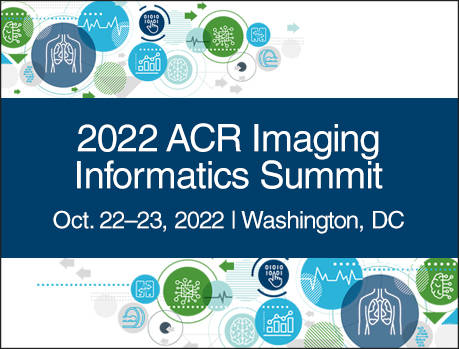Initial Experiences of a Radiology Data Science Team

Categories
February 19, 2019 |
Michael Moore, MD
Here’s a look at how we were able to implement radiology-specific data science initiatives and explore the use of AI to enhance the patient experience at Penn State Health.
Why develop a data science program?
Penn State Health is an academic radiology department with 50 radiologists subspecialized by division. Our residency programs graduate six diagnostic and one interventional resident per year. Like other academic radiology departments, the clinical and education missions are further supplemented by funded research. In our institution, this happens through an MRI core research facility and via supporting clinical trials.
As in many health systems, our hospital IT department controls much, if not all, of our institutional data. IT’s goals are determined at the highest level of the organization, and its priorities are well-defined. These objectives include storing information about patient clinical encounters, maintaining efficient billing and processes for covering insurance and other business needs, and protecting all of the data. Until recently, IT priorities have not included making data available and enabling data analysis at the departmental level.
When we began our AI journey, we came to a critical realization: We needed to collaborate with IT to enable an easier and more flexible approach to data access and analysis. Here’s why. Since structures in our hospital were originally put in place to efficiently use and safeguard data — rather than for data analysis — gaining access to data for other purposes was no easy task. We faced hurdles including a lack of clarity in data governance, poor or insufficient underlying data structure, and a disconnect between physicians’ data needs and IT’s abilities and priorities.
As an example, about six months ago, Penn State Health’s IT department expanded its data governance of our Radiology Information System (RIS) to directly integrate in the electronic medical record (EMR). This made RIS data less accessible to the radiologists who needed it most. While there are long-term billing (and possibly operational) benefits to this data structure change, in the short term, it created new challenges. To some degree, it further widened the divide between physicians and IT employees.
Despite these hurdles, the enormous potential benefit of using our data to extend Penn State Health’s AI capabilities and resources made it worthwhile for radiologists to get involved in data science beyond their other duties.
Building a team and defining objectives
Our radiology leadership at Penn State Health took the innovative approach of creating a team within the Department of Radiology to focus on two main areas: radiology-specific operational data analytics and exploring the use of AI to enhance the quality and safety of radiology. Our team was named DRIVE (Division of Radiology Innovation and Value Enhancement) and was envisioned as a bridge between radiology and IT.
Two radiologists serve as the co-directors of DRIVE. One director is “operationally” focused and the other “research” focused. However, deliberate coordination between the two areas creates a tightly integrated team. DRIVE is also supported by three full-time data scientists (employed by the Department of Radiology) with varying skill sets, including full-stack programming and statistical analysis. With this core structure, the team can provide resources for data science initiatives within the radiology department and work with faculty, staff, and residents on a range of other projects.
Which AI projects are worth pursuing?
For practical reasons, such as the desire for short-term deliverables, we began by using data readily available to us for AI projects. At the same time, we worked to overcome longer-term institutional data governance and cybersecurity concerns. Our DRIVE team simultaneously began focusing on non-interpretive data analysis initiatives designed for:
• Automating manual processes
• Enhancing the patient experience
• Streamlining operational efficiencies
Time-consuming manual processes are a good starting point for new AI projects. Because our institution uses the traditional “Resident Coverage with Subspecialist Over-reading” model of overnight staffing, we were interested in assessing discrepancies between residents’ preliminary interpretations and final staff’s interpretations for adult trauma patients1. Previously, this was a manual analysis process of querying the trauma database to identify patients and followed by a manual review of radiology reports. We needed a more timely and scalable automated process.
Using a rapid iterative process of development, we retrieved preliminary resident and final attending radiology reports for a specific time period and performed text analysis. The results: The time required for analysis of discrepancies between residents’ and radiologists’ interpretations dropped from several hours to 10 minutes per week. We were also able to demonstrate a low incidence of major discrepancies — those with the potential to change clinical management or patient harm.
With this more timely data analytics capability, we now can demonstrate the high quality of overnight resident interpretation, preserve this crucial educational experience, and maintain the value of subspecialty interpretation expertise.
Technology can also enhance the patient experience, which was the goal of our second major automation initiative. We were able to use chatbot technology to improve patient education prior to them undergoing breast biopsy. The chatbot provides supplemental patient educational information prior to routine patient-physician discussion. The technology was developed in conjunction with our breast imaging colleagues, who provided the chatbot discussion content.
Our initial pilot phase showed that the chatbot enhanced patient understanding of the procedure in 86% of patients. By accessing analytical data developed as part of the chatbot, we also determined that patients wanted to access the chatbot outside of the hospital setting and via their smartphones. We are now launching a full clinical implementation of the chatbot — enhanced with pictures and video — to all visitors to our breast center.
On the operational front, we found that data helps us run our department more efficiently. We have begun using data analysis to model historic radiology data to guide the operational performance of our specialty divisions. These analyses include assessing the overall staffing needs of the department, as well as daily staffing requirements to meet clinical needs. These tools are beginning to change the culture from a reactive, assumptive process to one that is proactive, predictive, and based on hard data.
Measurable results — with a little help
While there are hurdles to overcome, IT departments are beginning to recognize the benefits of providing departmental users with easier access to data. As we continue to collaborate on additional data science projects, they can see the value of granting access to radiology departments to meet our business needs. At the same time, they can better see the important role of data analysts in increasing efficiency and improving the patient experience.
By setting realistic project expectations, even a small data science team like ours can achieve measurable results. A radiology team with three dedicated data scientists has already been able to achieve success with both patient-centered and operationally focused AI projects. Our early successes make us pragmatically optimistic for the future of AI at our institution — and others like ours. We anticipate rapid development in this arena in the near future.
Michael M. Moore, MD, Associate Professor of Radiology and Pediatrics, and Nabeel I. Sarwani, MD, Professor of Radiology, Penn State Health System
ENDNOTES
1 Bruno M, Duncan J, Bierhals A, Tappouni R. Overnight Resident versus 24-hour Attending Radiologist Coverage in Academic Medical Centers . Radiology 2018 Sep 18:180690. doi:10.1148/radiol.2018180690. [Epub ahead of print] PMID: 30277849
Initial Experiences of a Radiology Data Science Team
-

You may also like
Solving Today's Informatics Problems, Building Tomorrow's SolutionsSeptember 23, 2022 | Ashley Prosper, MDAs radiologists, we strive to deliver high-quality images for interpretation while maintaining patient safety, and to deliver accurate, concise reports that will inform patient care. We have improved image quality with advances in technology and attention to optimizing protocols. We have made a stronger commitment to patient safety, comfort, and satisfaction with research, communication, and education about contrast and radiation issues. But when it comes to radiology reports, little has changed over the past century.